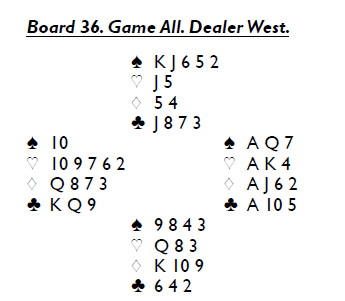Board 36. Game All. Dealer West. 
At nearly every table East will open 2NT or 2![]() in third position. After 2NT,West will transfer to (or bid) 3
in third position. After 2NT,West will transfer to (or bid) 3![]() , then continue with a practical 3NT or an aggressive 4
, then continue with a practical 3NT or an aggressive 4![]() (as 7
(as 7![]() might be possible with perfect cards in East and 6
might be possible with perfect cards in East and 6![]() with merely very good ones).
with merely very good ones).
Where East starts with 2![]() and West responds 2
and West responds 2![]() (neutral, negative, or 0/1 control) East’s 2NT rebid has a significantly higher maximum than a 2NT opening, so at these tables it will be more attractive for West to continue with 4
(neutral, negative, or 0/1 control) East’s 2NT rebid has a significantly higher maximum than a 2NT opening, so at these tables it will be more attractive for West to continue with 4![]() rather than 3NT.
rather than 3NT.
With all the aces and a double fit for the red suits, East is too strong to sign off at 4![]() over 4
over 4![]() (indeed, some will break the 3
(indeed, some will break the 3![]() transfer although doing so commonly implies four-card support). If West’s rounded-suit queen were in hearts and not clubs, 6
transfer although doing so commonly implies four-card support). If West’s rounded-suit queen were in hearts and not clubs, 6![]() would be very good and 6
would be very good and 6![]() playable.
playable.
In casual partnerships East can do no better than pick a strain and level or cue-bid a black ace, hoping for help from West. Over 4![]() , for example,West could either cue-bid a club control, show a club fragment, show spade shortage, or simply sign off at the five- or six-level, being careful not to go past diamonds as East may well be interested in slam in that suit.West’s action will depend on his own evaluation and his confidence in his agreements.
, for example,West could either cue-bid a club control, show a club fragment, show spade shortage, or simply sign off at the five- or six-level, being careful not to go past diamonds as East may well be interested in slam in that suit.West’s action will depend on his own evaluation and his confidence in his agreements.
This combination is particularly difficult for East because if there is a slam he believes it may be best in diamonds, but if there is no slam he’d like to play in hearts, for the extra 10 points a trick. One possibility is to treat opener’s continuations over 40 as specific: for example, 4![]() would deny real slam interest, perhaps even with two hearts, 4
would deny real slam interest, perhaps even with two hearts, 4![]() would set hearts strongly, 4NT would be a control rich maximum with no fit (with no fit and a modest hand opener can’t convert 4
would set hearts strongly, 4NT would be a control rich maximum with no fit (with no fit and a modest hand opener can’t convert 4![]() to 4NT and must scramble with 4
to 4NT and must scramble with 4![]() ), 5
), 5![]() a slam try for diamonds, 5
a slam try for diamonds, 5![]() a lesser hand with strong preference for play in diamonds, and 5
a lesser hand with strong preference for play in diamonds, and 5![]() could be reserved for slam hands with a double fit, as in this case. In a structure like this one, West could pass 5
could be reserved for slam hands with a double fit, as in this case. In a structure like this one, West could pass 5![]() , raise to 6
, raise to 6![]() , or convert to 6
, or convert to 6![]() .
.
Unfortunately, he will still be guessing, and it’s easy to see that he might guess wrong by going on to slam. In this case it would work better for West to continue with 3NT after transferring to hearts, offering a choice between 3NT and 4![]() . In effect, those who do not use transfers, will do the same by responding 3
. In effect, those who do not use transfers, will do the same by responding 3![]() , which covers a lot of ground but starts out being a game force with five or more hearts. East is expected to pass or convert in the first case and bid 3NT, raise, or make an advance cue-bid for hearts in the second.
, which covers a lot of ground but starts out being a game force with five or more hearts. East is expected to pass or convert in the first case and bid 3NT, raise, or make an advance cue-bid for hearts in the second.
This time it will be best for East to choose hearts, as he must lose the lead twice in notrump to develop both red suits and by then N/S will have their spades set up. In fact, declarer will have to avoid taking the diamond finesse late in the day to ensure 10 tricks. If he takes the finesse and the defenders have discarded accurately, he will lose the ![]() A.
A.
There will be a few fierce competitors (a.k.a. lunatics) who open the North hand in second position, vulnerable, with 2![]() (weak, spades and a minor) but they don’t rate to do much dam-age to their opponents, who will coast into 4
(weak, spades and a minor) but they don’t rate to do much dam-age to their opponents, who will coast into 4![]() or 3NT after East doubles,West responding 3
or 3NT after East doubles,West responding 3![]() . The only danger I can foresee for E/W at these tables is thatWest might stretch to jump to 4
. The only danger I can foresee for E/W at these tables is thatWest might stretch to jump to 4![]() , after which East will drive to a losing slam. As there are many ways for E/W to go wrong, the “normal” 4
, after which East will drive to a losing slam. As there are many ways for E/W to go wrong, the “normal” 4![]() , plus 650, will prove to be a very good result.And for the same reasons, plus 630 won’t be awful either. N/S pairs who score terribly for minus 650 will be left to wonder what they did to deserve such punishment. Well,there’s always tomorrow for those of you who want to get even.
, plus 650, will prove to be a very good result.And for the same reasons, plus 630 won’t be awful either. N/S pairs who score terribly for minus 650 will be left to wonder what they did to deserve such punishment. Well,there’s always tomorrow for those of you who want to get even.
Esta entrada también está disponible en: Spanish

